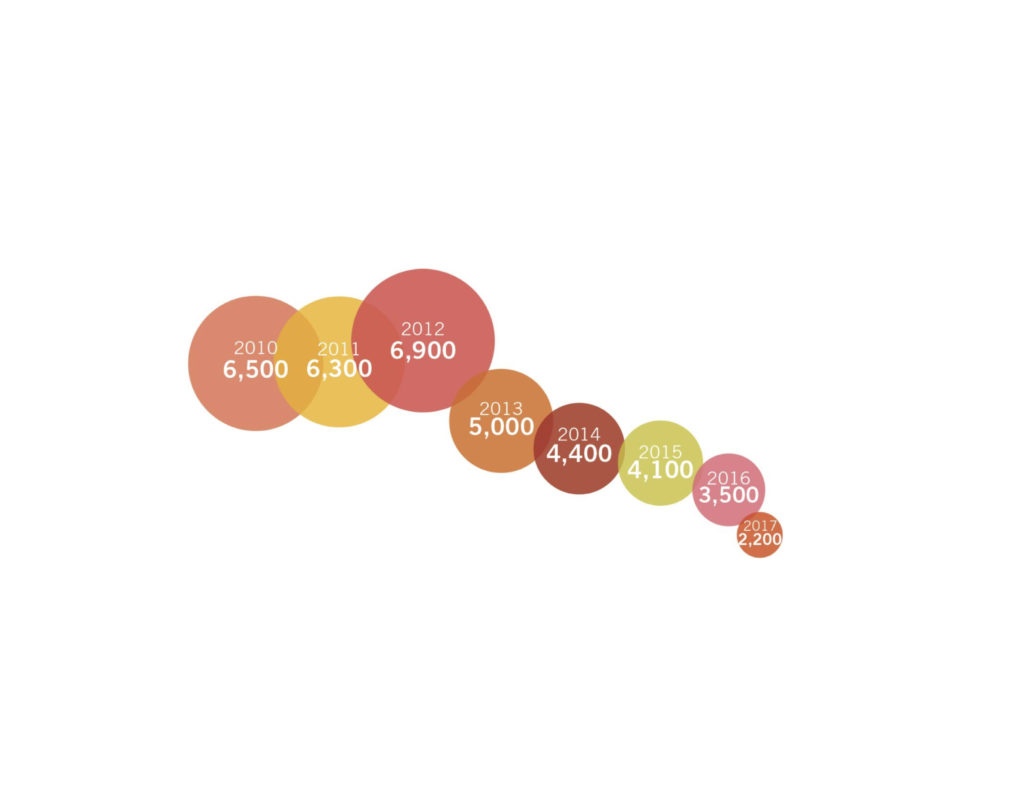Updated: Oct. 2, 2019 at 6:22 p.m.
The number of volunteers working for the University has dropped nearly 70 percent since 2012.
Despite administrative efforts to improve relationships with alumni, the number of volunteers working for GW has decreased from 6,900 in fiscal year 2012 to 2,200 in fiscal year 2017, according to University tax documents. Officials said the decrease could be attributed to changing priorities or inaccurate records, but alumni relations experts said the drop may indicate that alumni don’t feel a connection to GW or don’t know how their time supports the University.
University spokeswoman Lindsay Hamilton said the University enlists volunteers to assist in several offices, including alumni relations, admissions and housing. She said the decrease in the number of volunteers – which includes alumni, parents and students – reflects “both changes in the needs of the University and more detailed tracking of annual alumni volunteer engagement.”
She said the undergraduate admissions office no longer hosts admissions interviews, which were previously conducted by alumni volunteers. She said the University also previously reported an estimate of volunteers based on the number of alumni “to which we had access.”
“In recent years, we have worked to more accurately identify specific actions taken by individuals on an annual basis,” Hamilton said in an email. “This has helped us better identify meaningful opportunities for engagement and improved communications with current and prospective volunteers.”
She said the University is currently prioritizing alumni engagement – one of University President Thomas LeBlanc’s five strategic initiatives – and will create new positions for alumni volunteers in the coming months. She said about two dozen alumni volunteers assisted with move-in this year, and some alumni are being invited to partake in the President’s Council, a voluntary advisory group for “accomplished” alumni that will take shape early next year.
She declined to say how the decrease has impacted GW or what officials are doing to mitigate the impact.
Officials have boosted efforts to assess relationships with alumni as the University aims to increase its historically low alumni giving rate. University President Thomas LeBlanc traveled across the United States in the spring to detail his major priorities to donors, alumni and parents.
The Board of Trustees assembled a task force last year comprised of current students, alumni and trustees to focus on fundraising efforts and alumni engagement.
Martin Baum, the president of the GW Alumni Association, said alumni may not want to volunteer because they don’t feel connected with the University. He said GW’s location in a major city prevents many students from feeling like they are part of a community.
“It’s a little easier for the University of Virginias and the Dartmouths of the world because they are a little more isolated and a little more tight-knit,” he said.
Baum said alumni may not go out of their way to volunteer but will typically agree if asked.
Alumni relations experts said the University could be recruiting fewer volunteers because officials and staff are not emphasizing the importance of donating time.
Adrianne Denenberg, the director for affinity engagement and signature programs at Northeastern University, said the number of volunteers may have tumbled because alumni do not understand the benefits of working with the alumni office or have not found an area of volunteering they are interested in. Denenberg added that universities should recruit volunteers in the same way they pursue donations by having staff members dedicated to recruiting volunteers.
“You need to have someone stewarding someone giving their time because that’s our most prized possession,” Denenberg said.
Eric Johnson, the senior vice president for university advancement at Tufts University, said he has seen declines in volunteers in recent years at Tufts because staff members had inaccurately tracked the number. But he said the estimated decline, about 3 to 4 percent, was not as steep as that of GW.
He said a low volunteer turnout could mean alumni prefer the ease of donating instead of putting the time and energy into helping at a reunion or another activity. But GW’s alumni giving rate is the lowest of all its peer schools and has hovered between 8 and 9 percent in the past five years.
He added that recruiting alumni volunteers is a win-win for the University because the alumni who donate their time can also attract alumni who donate money.
“You help us do things that engage other alums and students and so, in doing that, you help us increase giving,” Johnson said.
Tricia Riveire, the senior executive director of the Indiana University Alumni Association, said officials need to communicate clearly with volunteers to keep them on board and ensure they understand how their time positively impacts the University.
If the number of volunteers is trending downward, volunteers may not see their value to the University, Riveire said.
“They don’t understand why it’s important, why it matters to the University, why it helps the University, other alumni, students and the future generations,” she said.
Andrew Shaindlin, an alumni strategy consultant with the higher education fundraising consulting firm Grenzebach Glier and Associates, said that making sure volunteers know the University appreciates their work is essential to retaining their services.
Students are encouraged to write thank-you notes to alumni who support the University during annual spring fundraising events.
“Saying ‘thank you’ publicly makes a big difference there, as does showing volunteers the impact that their work had on the school’s success,” Shaindlin said.





